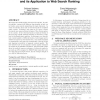47 search results - page 1 / 10 » Wordrank: A Method for Ranking Web Pages Based on Content Si... |
BNCOD
2007
13 years 6 months ago
2007
This paper presents WordRank, a new page ranking system, which exploits similarity between interconnected pages. WordRank introduces the model of the ‘biased surfer’ which is ...
WWW
2011
ACM
12 years 11 months ago
2011
ACM
Web pages are usually highly structured documents. In some documents, content with different functionality is laid out in blocks, some merely supporting the main discourse. In ot...
WISE
2005
Springer
13 years 10 months ago
2005
Springer
Existing search engines contain the picture of the Web from the past and their ranking algorithms are based on data crawled some time ago. However, a user requires not only relevan...
CORR
2011
Springer
12 years 8 months ago
2011
Springer
This Search engine became omnipresent means for ingoing to the web. Spamming Search engine is the technique to deceiving the ranking in search engine and it inflates the ranking. ...
WWW
2004
ACM
14 years 5 months ago
2004
ACM
Search engines use content and link information to crawl, index, retrieve, and rank Web pages. The correlations between similarity measures based on these cues and on semantic ass...

